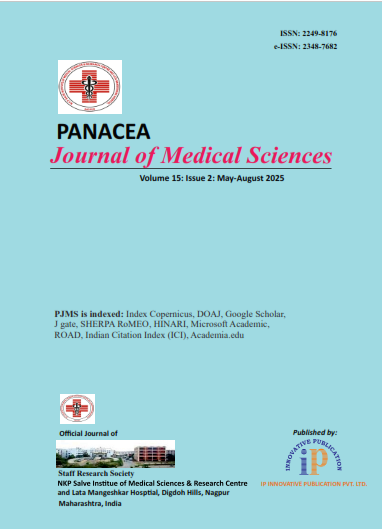Panacea Journal of Medical Sciences
Panacea Journal of Medical Sciences (PJMS) open access, peer-reviewed triannually journal publishing since 2011 and is published under auspices of the “NKP Salve Institute of Medical Sciences and Research Centre”. With the aim of faster and better dissemination of knowledge, we will be publishing the article ‘Ahead of Print’ immediately on acceptance. In addition, the journal would allow free access (Open Access) to its contents, which is likely to attract more readers and citations to articles published in PJMS.Manuscripts must be prepared in accordance with “Uniform requiremen...

To evaluate the visual outcome after phacoemulsification in diabetic patient and non-diabetic patient
Page: 346-350
Background: This study investigates visual outcomes after phacoemulsification in non-diabetic and diabetic patients, highlighting cataract as a complication of diabetes mellitus, which affects 285 million people globally. Cataract is the leading cause of blindness, impacting 18 million people worldwide, particularly in developing countries. In India, diabetes-induced cataracts account for 20% of cases. Despite advancements in phacoemulsification making cataract surgery safer and more predictable with rapid visual recovery, diabetic patients still experience poorer visual prognoses. This is attributed to elevated osmotic stress, oxidative stress, and non-enzymatic glycation of lens proteins.
Materials and Methods: The study involved 398 participants, evenly split into diabetic and non-diabetic groups aged 50 to 80 years. The selection criteria included visual acuity (VA) less than 6/18, well-controlled diabetes, and the absence of retinopathy and macular oedema. Post-operative uncorrected visual acuity (UCVA) and best-corrected visual acuity (BCVA) were recorded at 15-day intervals up to 45 days for all patients. Data were compiled using Microsoft Office 2010 and exported to SPSS version 29.0.01 (IBM SPSS) for analysis.
Results: Indicated that younger patients had significantly better visual outcomes compared to older patients. Although both groups showed substantial improvement after cataract surgery, diabetic patients had poorer postoperative visual outcomes.
Conclusion: Phacoemulsification significantly improves visual outcomes in both diabetic and non-diabetic patients; however, diabetic patients, despite having well-controlled diabetes and no retinopathy or macular oedema, demonstrate comparatively poorer postoperative visual recovery. Younger patients tend to achieve better results, highlighting the influence of age and underlying metabolic factors on surgical prognosis.
Article Metrics
- Visibility 23 Views
- Downloads 7 Views
- DOI 10.18231/pjms.v.15.i.2.346-350
-
CrossMark
- Citation
- Received Date July 23, 2024
- Accepted Date December 27, 2024
- Publication Date August 19, 2025